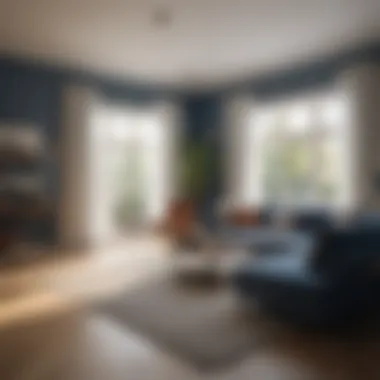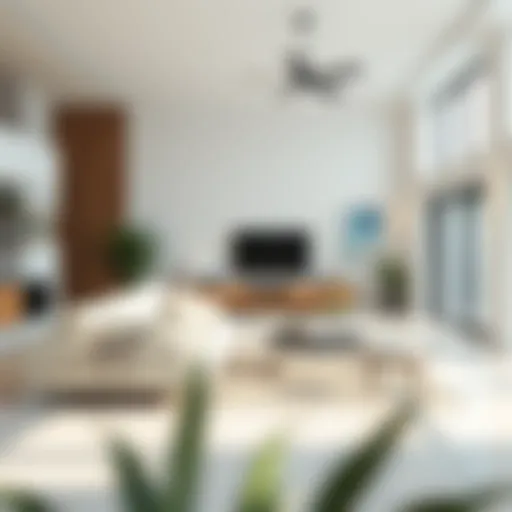Mastering Room Measurements: Effective Techniques


Intro
Accurate measurement of room square footage is a fundamental skill that serves various practical purposes. From real estate assessments to interior design projects, knowing how to accurately determine the space available can influence decisions significantly. As the demand for functional living spaces grows, mastering effective techniques for measuring square footage becomes essential. This article will outline methodologies, tools, and practical considerations necessary for this task.
Understanding square footage is not merely about numbers; it reflects on how spaces are perceived, used, and optimized. A well-measured area can enhance property valuation, streamline interior arrangements, and promote efficient utilization of available environment. By the end of this guide, readers will be equipped with knowledge and confidence to assess room dimensions, whether for personal use or professional projects.
Home Features
When evaluating how to measure room square footage effectively, it is essential to consider home features. Each space has unique elements that affect measurement.
Architectural Marvels
Architectural layouts can vary significantly between homes. High ceilings, alcoves, or built-in furniture can obscure straightforward measurements. Consider these aspects:
- Vaulted Ceilings: Measure the floor area, but recognize that the volume may impact the overall aesthetic.
- Nooks and Cambers: For unique indentations, ensure that you include these areas by calculating them separately before integrating them into the total square footage.
Unique Design Elements
Certain design features, such as open floor plans or segmented spaces, impact how square footage is perceived and calculated.
- Open Spaces: These can create visual continuity and are often easier to measure.
- Divided Rooms: Measure each section separately and sum them for an accurate total.
To ensure complete accuracy, always double-check your measurements. A single miscalculation can lead to misunderstandings both in real estate and design contexts.
Tools for Measurement
Accessing the proper tools makes measuring room square footage simple and straightforward. Accurate tools ensure precision and efficiency.
- Measuring Tape: A common tool offering good flexibility for various spaces.
- Laser Distance Measurer: This device offers accuracy and ease of use, particularly in large areas.
- Floor Plan Apps: Many mobile applications can assist in digitalizing measurements and creating floor plans effortlessly.
Measurement Techniques
The techniques employed when measuring room square footage can significantly affect results. A systematic approach is advisable.
- Traditional Measurements: Start by measuring the length and width of the room with a tape measure. The basic formula is Length x Width = Square Footage.
- Irregular Spaces: For asymmetrical rooms, divide the space into simpler shapes, calculate each area, and sum the results.
- Consider Built-ins: If there are closets or other built-in elements, remember to include or exclude them in accordance with your plans.
By mastering these tools and techniques, anyone can confidently measure room square footage, ensuring spaces are utilized to their fullest potential.
Foreword to Measuring Square Footage
Measuring square footage is more than a mere mathematical exercise; it is a fundamental skill that impacts a range of practical applications. Understanding the measurements of a room or space plays a critical role in various fields such as real estate, interior design, and urban planning. An accurate assessment allows owners, tenants, and professionals to make critical decisions regarding property value, layout, and efficient space utilization.
Importance of Accurate Measurements
Accuracy in measuring square footage is vital for several reasons. First, it helps in ensuring transparency in real estate transactions. Buyers and sellers need to know the precise dimensions of a property. This is essential because square footage directly influences market value. Incorrect measurements can lead to financial losses and disputes.
Moreover, accurate measurements contribute to effective space planning. In interior design projects, understanding the exact dimensions allows for better customization of furniture and enhancement of aesthetic appeal.
In addition, accurate room measurements are necessary for compliance with building codes, zoning regulations, or lease agreements. Many times, these regulations specify minimum sizes for rooms, and any deviation from them can cause legal or financial repercussions. Ultimately, accurate measurements foster informed decisions across various domains, highlighting their broader significance.


Common Misconceptions
There are several misconceptions surrounding the process of measuring square footage that can lead to errors. One common myth is that all rooms must be measured in the same way. Some may believe that simply rounding up measurements is sufficient, but this can result in significant discrepancies, especially in larger properties.
Another misconception is that unusual features of a room, like alcoves or built-in furniture, can be ignored during measurement. In reality, these elements can substantially affect both functionality and aesthetic layout. Ignoring them can lead to inadequate planning, which impacts usability.
Furthermore, many people underestimate the value of double-checking their measurements. Measuring a room only once often causes mistakes, whether due to miscounting or simple human error. A second measurement can help verify the accuracy and alleviate any concerns.
Understanding these common misconceptions and acknowledging the importance of accuracy can significantly improve the process of measuring room square footage.
Tools for Measuring Square Footage
Accurate measurement of square footage hinges on selecting the right tools. Each tool serves a distinct purpose and has its own advantages. Understanding which tool to use in specific circumstances is crucial. The tools available can enhance the functionality and precision of measurements, impacting decisions made in real estate, design, or other projects where space details are vital.
Tape Measure
A tape measure is a staple for anyone looking to measure square footage. It is straightforward to use and provides quick results. Typically, tape measures come in lengths from 12 to 25 feet or more for larger spaces. With markings for feet and inches, they allow for detailed measurements of any room. Using a tape measure is ideal for measuring smaller spaces. However, it requires physical presence in the room to get accurate numbers, which can be time-consuming.
Benefits of using a tape measure include:
- Cost-effectiveness
- Availability in most hardware stores
- Ease of portability
Nevertheless, tape measures can be less efficient for larger spaces, as they might require multiple readings and calculations. Additionally, users may misread the markings, leading to inaccurate results.
Laser Measure
Laser measures introduce an innovative approach to measuring room square footage. These devices use laser beams to calculate distances with exceptional accuracy. Measuring large areas becomes quick and accurate, as they eliminate the need for physical handling in large spaces. Users only need to point and activate the device.
Advantages of a laser measure:
- High precision with readings often accurate to within 1/16 of an inch
- Ability to measure distances over long ranges, up to hundreds of feet
- Often integrated with calculating features, which simplifies square footage measuring
While typically more expensive than tape measures, laser options offer greater efficiency for extensive spaces where detail matters. Keeping in mind that laser measures depend on line-of-sight, it is essential to avoid obstructions that may interfere.
Smartphone Apps
Smartphone apps represent a modern and accessible method for measuring square footage. These applications can utilize a phone's camera and other sensors to assist in obtaining measurements. Some apps offer augmented reality features, enabling users to visualize dimensions and overlays directly in the physical space.
Potential strengths of smartphone apps:
- Convenient, as most users already own smartphones
- Various options available for free or a nominal fee
- User-friendly interfaces that cater to different skill levels
Yet, the accuracy can vary based on factors such as the phone's camera quality and the inherent limitations of the app. Large areas may still require additional verification with traditional methods to ensure precision.
In summary, choosing the right tool for measuring square footage is fundamental. Each option, whether it is a tape measure, a laser measure, or a smartphone app, has unique advantages and challenges. The right choice often depends on the specific needs of the project, the space to be measured, and the preference of the user.
Standard Techniques for Measuring Rooms
Understanding standard techniques for measuring rooms is crucial for anyone involved in real estate, interior design, or space optimization. Accurately measuring room dimensions ensures that decisions about usage, layout, and design can be made effectively. In this section, we will discuss the methods that serve as a backbone for measuring effectively, highlighting the importance of precision and consistency. These techniques provide clarity in planning, helping to avoid costly mistakes in future projects.
Measuring Rectangular Spaces


Measuring rectangular spaces is one of the most straightforward techniques utilized in room measurement. The formula for calculating square footage in these areas is simple: multiply the length by the width. To begin, it is essential to take precise measurements of each side. Use a tape measure or laser measure for accuracy. Record these measurements carefully. For example, if a room is 12 feet long and 10 feet wide, the calculation will yield 120 square feet. This method is not just efficient; it is intuitive.
Tips for Measuring Rectangular Spaces:
- Ensure the tape or laser is straight: This avoids discrepancies that can arise from measuring at an angle.
- Double-check your measurements: It is wise to measure each side twice to confirm accuracy.
- Consider height for volume: In some cases, knowing the height can help in applications beyond square footage, like determining heating and cooling efficiency.
Measuring Irregular Shapes
Measuring irregular shapes requires more thought and planning than rectangular spaces. The process begins by breaking down the shape into smaller, manageable rectangles or squares. After determining these dimensions, the measurements for each rectangle can be taken individually, calculated, and then summed up for the total area.
Steps for Measuring Irregular Shapes:
- Sketch the layout: A rough sketch helps visualize sectioning the area into smaller squares or rectangles.
- Measure each segment separately: Using the same measuring tools, take careful measurements of each smaller section.
- Calculate the total area: Add the individual square footage of all segments together to get the total area of the irregular shape.
Including Built-In Features
Built-in features can complicate the measuring process. These include elements such as cabinets, closets, and architectural nooks. It is essential to consider these when calculating square footage, as they can significantly impact how space is used. To measure effectively, ensure that these built-in features are either subtracted from the total area or included as separate measurements to provide a complete picture of room dimensions.
Considerations for Built-In Features:
- Measure around features: Make sure to note the space occupied by any built-in features in your total calculations.
- Document additional features: Any built-in storage or architectural detail can affect the functionality of the space and should be noted down.
- Use visual aids: If necessary, use graph paper to help account for the complexities of the layout.
In summary, mastering standard techniques for measuring rooms enhances not only the accuracy of the measurements but also the effectiveness of subsequent applications, like design and utilization planning.
Calculating Square Footage
Calculating square footage is essential for various purposes such as real estate valuation, interior design, and space optimization. Accurate measurements of a room’s square footage can significantly influence decisions regarding property investment, design implementation, and effective use of space. Whether you're evaluating a potential purchase, planning a renovation, or simply ensuring your space meets your needs, understanding square footage provides the foundation for informed choices.
When you calculate square footage correctly, you gather crucial data that can help in estimating costs or determining fair market value. Accurate measurements allow for effective comparison between similar properties in the market. Moreover, for interior designers, knowing exact square footage ensures that the arrangement of furniture and decor fits well within a given space, enhancing aesthetic appeal without compromising functionality.
The Simple Formula
Calculating the square footage of a room involves a straightforward formula. For a rectangular room, the formula is:
Square Footage = Length × Width
Start by measuring the length and width of the space in feet. If a room is irregularly shaped, it is best to break it down into smaller, manageable rectangles or squares, calculate their individual square footage, and then sum those amounts for the total area.
When measuring, ensure you are not including non-livable areas such as thick walls or alcoves, as they do not contribute to usable square space.
Make sure that the measurements are accurate. Even a small error can impact the total square footage significantly. For example, if you measured a 10ft by 12ft room and accidentally added an inch to the length, it would alter the square footage from 120 square feet to 120.5 square feet, which may seem minor, but can lead to drastic differences in various applications like flooring material purchases.
Tips for Accuracy
To ensure the most precise calculation of square footage, consider the following tips:
- Double Check Measurements: Always measure twice to prevent errors. A slight mistake can make a significant difference in square footage calculations.
- Use a Reliable Tool: Employ a quality tape measure or a laser measuring device for accuracy. Laser measures can be particularly helpful in larger spaces where longer stretches may be difficult to gauge manually.
- Consider the Exact Shape: For rooms that are not perfectly rectangular, take systematic measurements and break them down into smaller rectangles. This method simplifies the calculations and enhances accuracy.
- Account for Features: Remember to include any built-in features such as closets or alcoves, as these areas contribute to the overall square footage but may often be overlooked.
- Document Everything: Keep a record of your measurements along with sketches of the room layout. This can help you visualize the space and makes revisiting calculations easier if needed later.
By applying these strategies, the process of calculating square footage becomes more reliable, ensuring that the measurements you obtain are conducive to effective planning and designing.
Practical Applications of Square Footage Measurements


Understanding room square footage is crucial for various practical applications. Accurate measurements enable individuals to make informed decisions in scenarios like buying a house, planning renovations, or optimizing spaces for specific purposes. Here, we explore three main applications of square footage measurements: real estate valuation, interior design projects, and space planning and optimization.
Real Estate Valuation
In real estate, square footage plays a vital role in determining a property's value. Appraisers and agents use these measurements to assess comparable properties in similar markets. The value assigned to a home often correlates to its size, thus impacting pricing strategies. Accurate square footage can help in:
- Setting realistic listing prices
- Negotiating offers and counteroffers
- Comparing properties effectively for potential buyers
For example, a home measuring 2,500 square feet might be valued higher than another at 1,800 square feet, even with similar amenities. However, it is essential to take into account local market factors as well. Buyers should always verify square footage claims made by sellers or represented in listings to ensure they are making decisions based on accurate information.
Interior Design Projects
Interior designers rely on precise measurements to create effective layouts. Square footage informs designers on how much furniture can fit comfortably, helping create a balanced and functional space. Furthermore, understanding square footage allows designers to:
- Choose appropriate furnishings
- Plan effective traffic flow
- Ensure compliance with local codes and standards
For instance, knowing that a living room is 300 square feet allows a designer to calculate how large a sectional sofa can be, and whether a coffee table fits without obstructing movement.
Space Planning and Optimization
Space planning involves strategically organizing various elements within a room or building, often driven by square footage data. Businesses, for instance, must consider how to best utilize every square foot to enhance productivity and customer experience. Key considerations include:
- Workstation arrangement in offices
- Arrangement of displays in retail environments
- Reducing wasted space in residential areas
By analyzing square footage, professionals can create layouts that promote efficiency. For example, an office that is 1,000 square feet but poorly laid out may feel cramped. Reassessing the square footage and reconfiguring workspaces or common areas can optimize overall functionality.
"Accurate measurements are the foundation of effective space planning and optimization. Without them, inefficiencies may arise."
Common Mistakes When Measuring
Accurate measurement of square footage is crucial for various applications, such as real estate transactions and interior design plans. However, even experienced individuals can fall prey to common mistakes during the measuring process. Avoiding these errors ensures that you have a precise understanding of the dimensions involved, leading to better decisions in space planning. Attention to detail here can save you from costly consequences down the road, such as misinforming potential buyers or miscalculating renovation costs.
Neglecting Unusual Features
When measuring a room, it is easy to overlook unusual features like alcoves, nooks, or wall projections. These elements can significantly alter the usable square footage, and neglecting them can lead to substantial inaccuracies.
- Measure All Areas: For instance, if a room has a built-in bookcase or a chimney breast, these should be included in the total measurement. Not doing so can create a misleading representation of space.
- Consider Floor Plans: Referring to floor plans can also guide you in identifying features that may not be immediately apparent when standing in the room. An accurate floor plan might serve as a good starting point for your measurements.
Furthermore, non-standard features such as sloped ceilings in attics or vaulted ceilings can also affect your calculations. These areas often require careful measuring techniques to ensure accurate square footage representation. By disregarding these features, you risk underestimating the space that can be utilized, impacting design and investment decisions.
Not Accounting for Architectural Elements
Architectural elements like columns, beams, and molding should not be ignored in measurements. They can play a critical role in determining the effective use of space. Here are key considerations:
- Columns and Beams: When measuring rooms with columns or large beams, it is essential to account for their impact. While they may not occupy much floor space, they can impede furniture placement and flow of movement. Not including these elements in your planning can lead to design challenges.
- Thickness of Walls: Another important consideration is the thickness of walls. In cases of thick walls or built-in cabinetry, the actual usable area of a room can be reduced. Overlooking this can mislead in decisions regarding potential use of space.
"Ignoring architectural elements can result in wasted space and increased costs due to redesigns or modifications."
Ending
Accurate measurements of room square footage stand as a critical foundation for various domains such as real estate, interior design, and strategic space planning. This article emphasizes the importance of reliable techniques and tools to achieve correct square footage measurements. When considering a property's value, knowing the exact square footage helps assess its market position and appeal. For designers, an understanding of available space enhances their ability to curate functional layouts and choose appropriate furnishings.
Furthermore, inaccuracies in measurement can lead to detrimental consequences. These might include mispricing properties, inefficient space usage, or unsatisfactory design outcomes. Such errors may not only cost time but can also result in unnecessary expenses. Therefore, prioritizing accuracy in measurements is essential in every context where square footage plays a role.
Being aware of common mistakes, as discussed earlier, helps avoid pitfalls. Utilizing recommended tools effectively allows for a clearer understanding of space dimensions. As a result, the knowledge gained from this article equips readers with the ability to measure with confidence, ensuring their projects or property dealings are based on solid, precise information.
"In the world of property and design, the smallest miscalculation can lead to the biggest problems."



